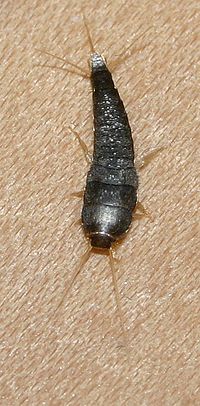Silverfish
From Wikipedia, the free encyclopedia
| Lepisma saccharina | ||||||||||||||
|---|---|---|---|---|---|---|---|---|---|---|---|---|---|---|
 |
||||||||||||||
| Scientific classification | ||||||||||||||
|
||||||||||||||
| Binomial name | ||||||||||||||
| Lepisma saccharina Linnaeus, 1758 |
Lepisma saccharina (commonly called the fishmoth, urban silverfish, or just silverfish) is a small, wingless insect typically measuring from a half to one inch (12–25 mm). Its common name derives from the animal's silvery blue colour, combined with the fish-like appearance of its movements, while the scientific name indicates the silverfish's diet of carbohydrates such as sugar or starches. It belongs to the basal insect order Thysanura, a group estimated to have existed for over 300 million years, at least since the Paleozoic Era.[1]
Contents |
[edit] Habitat
As with many colorless or nearly colorless invertebrates, silverfish inhabit dark areas like within kitchen cupboards of houses.
An eyeless species of silverfish, or a close relative, was discovered in January 2006 in caves in Sequoia National Park, California.
[edit] Diet
The favorite food of silverfish is any matter that contains starch or polysaccharides, such as dextrin in adhesives. These include glue, book bindings, paper, photos, sugar, hair, and dandruff. Silverfish can also cause damage to books, tapestries, and textiles. Silverfish will commonly graze in and around showers, baths, and sinks on the cellulose present in many shampoos, shaving foams and so on. Apart from these cases, the damage caused by silverfish is negligible and they have no direct effect on human health beyond psychological distress to those who are frightened or disgusted by their appearance, or to those whose books have been destroyed by the creatures. Other substances that may be eaten include cotton, linen, silk and synthetic fibers, and dead insects or even its own exuvia (moulted exoskeleton). During famine, a silverfish may even attack leatherware and synthetic fabrics. In extreme cases, silverfish may live for one year without eating.[2] Silverfish can be found anywhere in homes including, but not limited to, garages, closets, underneath beds, couches, electrical appliances such as keyboards and generally preferring dark areas.
[edit] Reproduction and growth
The reproduction of silverfish is preceded by a "love dance", involving three phases, which may last over half an hour. In the first phase, the male and female stand face to face, their trembling antennae touching, then repeatedly back off and return to this position. In the second phase the male runs away and the female chases him. In the third phase the male and female stand side by side and head-to-tail, with the male vibrating his tail against the female.[3] Finally the male lays a spermatophore, a sperm capsule covered in gossamer, which the female takes into her body via her ovipositor to fertilize the eggs she will lay later on.
Young silverfish are white in color.
Under laboratory conditions, silverfish may go through between 17 and 66 molts, much more than usual for an insect. Silverfish are one of the rare species of insect that continue to molt after mating.[4]
[edit] Predation
Earwigs, house centipedes, and (in rare cases) spiders are known to be predators of silverfish.
| Wikimedia Commons has media related to: Lepisma saccharina |
| Wikispecies has information related to: Lepisma saccharina |
[edit] References
- ^ Barnes, Jeffrey K. (October 6, 2005). "Silverfish". Arthropod Museum Notes. University of Arkansas. http://entomology.uark.edu/museum/silfsh.html. Retrieved on 2008-12-25.
- ^ Day, Eric (August, 1996). "Silverfish factsheet, Department of Entomology". Virginia Cooperative Extension. Virginia Polytechnic Institute and State University, Virginia State University. http://www.ext.vt.edu/departments/entomology/factsheets/silverfi.html. Retrieved on 2008-12-25.
- ^ Von H. Sturm (1965) Die Paarung beim Silberfischen, Lepisma saccharina. In Zeitschrift fur Tierpsychologie, Band 13, Heft 1.
- ^ Hubbell, Sue (1993). Broadsides from the Other Orders. ISBN 0-679-40062-1.
[edit] External links
- Klass, Carolyn (11/1981; updated 12/2008). "Silverfish and Firebrats". Cornell University. http://www.entomology.cornell.edu/public/IthacaCampus/ExtOutreach/DiagnosticLab/Factsheets/SilverfishFirebrats.html. Retrieved on 2008-12-25. At Cornell Cooperative Extension, Insect Diagnostics Laboratory
- "Magnified pictures of Silverfish". Mount Allison University. http://www.mta.ca/dmf/silverfish.htm. Retrieved on 2008-12-25.



